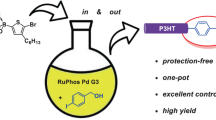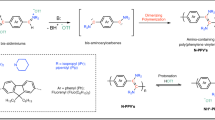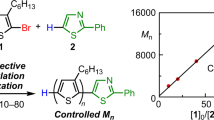Abstract
The compound fac-Ir(ppy)3 (fac, facial; ppy, 2-phenylpyridyl) end-functionalized poly(4-diphenylaminostyrene) (PDAS) was synthesized by adding fac-Ir(ppy)2(vppy) (vppy,2-(4-vinylphenyl)pyridyl) to poly(4-diphenylaminostyryl)lithium (PDASLi). In this reaction, fac-Ir(ppy)2(vppy) acts as a fac-Ir(ppy)3 single-monomer addition reagent for PDASLi. The first fac-Ir(ppy)2(vppy) molecule readily binds to the carbanion of PDASLi, but the addition of a second fac-Ir(ppy)2(vppy) molecule to the carbanion on the vinyl group of fac-Ir(ppy)2(vppy) does not proceed. Thus, fac-Ir(ppy)3 end-functionalized PDAS, which consists of one PDAS molecule and one fac-Ir(ppy)3 molecule, was successfully obtained for the first time.
Similar content being viewed by others
Introduction
Among various semi-conducting polymers, poly(4-diphenylaminostyrene) (PDAS), a stable and soluble triphenylamine-containing polymer, has been recognized as an attractive hole-transport polymer for optoelectronic applications.1, 2, 3, 4, 5, 6, 7, 8, 9, 10, 11, 12, 13, 14, 15, 16, 17, 18, 19 To obtain PDAS with a well-defined and well-controlled polymer chain structure, different anionic,1, 3 radical and living radical1, 2, 4, 5, 6, 7, 8, 9, 10, 11 methods have been performed using 4-diphenylaminostyrene (4-DAS), the monomer of PDAS. However, the controlled polymerization of 4-DAS is considerably difficult, even with living radical polymerization.
To obtain PDAS with a well-defined polymer chain structure,12, 13, 14, 15, 16, 17, 18, 19 we discovered the first successful living anionic polymerization of 4-DAS.12 Subsequently, the stereoregularity and the properties of PDAS were revealed,12, 14 and the living anionic polymerization of 4-DAS was expected to help producing various end-functionalized PDAS.13, 18 Among them, the semi-conducting polymer fac-Ir(ppy)3 (fac, facial; ppy, 2-phenylpyridyl) end-functionalized PDAS has been a good candidate for organic light-emitting diodes (OLEDs) because PDAS has good solubility14 and fac-Ir(ppy)3 is an outstanding phosphorescent material. If this end-functionalized PDAS is successfully obtained, a homogeneous dispersion of fac-Ir(ppy)3 for effective triplet energy transfer seems achievable.
We have previously demonstrated20 that fac-Ir(ppy)2(vppy) (vppy=2-(4-vinylphenyl)pyridyl) can act as a single-monomer addition reagent for poly(1,3-cyclohexadienyl)lithium (PCHDLi, a living polymer of poly(1,3-cyclohexadiene)) to produce fac-Ir(ppy)3 end-functionalized poly(1,3-cyclohexadiene) (Scheme 1, living polymer=PCHDLi). The results indicated that this reaction was an effective method to obtain various fac-Ir(ppy)3 end-functionalized polymers with well-controlled and defined polymer chain structures.
In our previous publication,13 we demonstrated that the PDAS carbanion has a lower nucleophilicity than the poly(1,3-cyclohexadiene) carbanion. In other words, fac-Ir(ppy)2(vppy) was considerably more difficult to add to poly(4-diphenylaminostyryl)lithium (PDASLi, a living polymer of PDAS) than to PCHDLi. Therefore, it was important to examine the possibility of fac-Ir(ppy)2(vppy) as a fac-Ir(ppy)3 single-monomer addition reagent for PDASLi. There upon, we attempted to add fac-Ir(ppy)2(vppy) to PDASLi to synthesize fac-Ir(ppy)3 end-functionalized PDAS.
Herein, we report the first successful synthesis of fac-Ir(ppy)3 end-functionalized PDAS. The characteristics of the fac-Ir(ppy)2(vppy)-to-PDASLi addition reaction are also discussed in detail.
Experimental Procedure
Materials
Toluene (⩾99.8%) was refluxed over calcium hydride (CaH2, 95%) and then distilled under dry argon. Methyltriphosphonium bromide (⩾98.0%) and 4-(2-pyridyl)benzaldehyde (⩾95.0%) were dried under reduced pressure. The compound 4-DAS12 and 2-(4-vinylphenyl)pyridine20 were prepared via the previously reported standard Wittig reactions. Tetrakis(2-phenylpyridine-C2,N′)(μ-dichloro)diiridium (Ir(ppy)2Cl)2 was prepared according to a procedure described in the literature,21 and fac-Ir(ppy)2(vppy) was prepared according to our previously reported procedure.20 Other reagents were used as received, unless stated otherwise. Methyltriphosphonium bromide, 4-(2-pyridyl)benzaldehyde and 2-phenylpyridine (⩾98.0%) were purchased from Tokyo Chemical (Tokyo, Japan). Iridium(III) chloride trihydrate (IrCl3·3H2O, ⩾90.0%) was purchased from Kanto Chemical (Tokyo, Japan). All other reagents were purchased from Sigma-Aldrich (St Louis, MO, USA).
Preparation of PDASLi
All substances were added into the container using a syringe. The compound 4-DAS (0.50 g, 1.85 mmol) was placed in a completely dry 50 ml Schlenk tube and dried under reduced pressure. The Schlenk tube was alternatively evacuated and filled with dry argon several times, after which 10.0 ml of toluene was added at room temperature (ca. 25 °C). Then, t-buyllithium (t-BuLi; 1.70 mol l−1 in pentane, 0.120 or 0.170 mmol) was injected into this solution, and the reaction mixture was magnetically stirred under dry argon at room temperature for 3 h, producing PDASLi in ca. 70 wt% yield. (Note: Although the best initiator for the anionic polymerization of 4-DAS was the benzyllithium/N,N,N′,N′-tetramethylethylenediamine system,12 in this study, t-BuLi was used as an initiator in order to simplify the analysis of proton nuclear magnetic resonance (1H NMR) spectrum of fac-Ir(ppy)3 end-functionalized PDAS.)
Addition of fac-Ir(ppy)2(vppy) to PDASLi
A completely dry 150 ml Schlenk tube was purged with dry argon, and fac-Ir(ppy)2(vppy) (0.25 wt% solution in toluene) was added at room temperature (ca. 25 °C) using a syringe. A toluene solution of PDASLi was then injected to this Schlenk tube, and the reaction mixture was magnetically stirred under dry argon at room temperature for 96 h. Afterward, to terminate the addition reaction, dry methanol (MeOH, ⩾99.8%) was added to the reaction mixture in an equimolar amount to the amount of Li atoms present in the mixture. Then, the reaction mixture was poured into a large volume of ethanol (EtOH) to precipitate the polymer, which was separated by filtration. The product was washed with excess EtOH and dried under reduced pressure at room temperature for 24 h, resulting in a powdery orange polymer.
Measurements
The number of average molecular weight (Mn), the weight of average molecular weight (Mw) and the polydispersity index (Mw/Mn) were determined using a gel permeation chromatography equipment with a differential refractive index detector (Shimadzu RID-6A (Shimadzu, Kyoto, Japan)), a ultraviolet detector (Shimadzu SPD-6 A) and a Shimadzu Shim-pack GPC-80M column (length: 300 mm, diameter: 8 mm, effective molecular weight range of 100–4 000 000) at 40 °C. Tetrahydrofuran (THF) was used as the eluent, and the flow rate was 1.00 ml min−1. A molecular weight calibration curve was obtained using the polystyrene standards. The 1H NMR spectra were measured in deuterated chloroform or THF (THF-d8) at 500 MHz using a Jeol ECA 500 spectrometer (Jeol, Tokyo, Japan).
Results and Discussion
Synthesis of fac-Ir(ppy)2(vppy)
According to our previously reported procedure (Scheme 2),20 the synthesis of fac-Ir(ppy)2(vppy) was performed at 120 °C in 2-ethoxyethanol for 24 h. The obtained result is the thermodynamically favored fac-isomer (that is, fac-Ir(ppy)2(vppy), an orange powdery compound) with relatively high yield (ca. 48%). The complex was soluble in THF and partially soluble in EtOH, chloroform, dichloromethane and toluene.
Figure 1 shows a typical 1H NMR spectrum of fac-Ir(ppy)2(vppy). The peaks from 6.6 to 7.9 p.p.m. (Ha=3H, Hb,c,d=9H and He,f,g=11H) and from 4.8 to 6.5 p.p.m. (Ho=1H, Hp=1H and Hq=1H) were assigned to aromatic and olefinic protons, respectively, as previously reported.22 The complexation of the Ir(III) ion led to a general diamagnetic shift of the 1H NMR signals of fac-Ir(ppy)2(vppy).
Synthesis of fac-Ir(ppy)3 end-functionalized PDAS
We have previously reported14 that PDAS is an excellent semi-conducting polymer, and fac-Ir(ppy)3 is an outstanding phosphorescent material. Thus, it was expected that fac-Ir(ppy)3 end-functionalized PDAS would be a suitable material for OLEDs. To obtain fac-Ir(ppy)3 end-functionalized PDAS, fac-Ir(ppy)2(vppy) was added to PDASLi under various reaction conditions. The result showed that this addition reaction was unstable: the addition of polar additives, such as ethers (or amines), caused fac-Ir(ppy)2(vppy) to decompose, and a high reaction temperature deactivated PDASLi. From the results obtained, the optimized reaction condition was found.
Scheme 3 illustrates that fac-Ir(ppy)2(vppy) was added to PDASLi ([4-DAS]0/[t-BuLi]0=15.4) (Note: Although the best initiator for the anionic polymerization of 4-DAS was the benzyllithium/N,N,N′,N′-tetramethylethylenediamine system,12 in this study, t-BuLi was used as an initiator in order to simplify the analysis of 1H NMR spectrum of fac-Ir(ppy)3 end-functionalized PDAS) under dry argon in toluene at room temperature for 96 h ([fac-Ir(ppy)2(vppy)]0/[PDASLi]0 molar ratio=1.20/1.00); the reaction produces an orange product in almost quantitative yield.
Figure 2 shows the gel permeation chromatography traces of the original PDAS (Figure 2a) and the reaction product (Figure 2b). The Mn value of the reaction product (5800 g mol−1, polydispersity index=1.24) was greater than that of the original PDAS (Mn=4590 g mol−1, polydispersity index=1.27), which suggests that fac-Ir(ppy)2(vppy) was successfully added to PDASLi.
Typical 1H NMR spectra of the original PDAS and the reaction product are shown in Figure 3. For the original PDAS (Figure 3a), the peaks from 6.4 to 7.3 p.p.m. were assigned to the aromatic protons (Hv) in the 4-DAS units. The peaks from 1.2 to 2.5 p.p.m. were assigned to the methine and methylene protons (Hw) in the 4-DAS units. The peaks approximately 0.9 p.p.m. were assigned to the methyl protons (Ht) in the t-butyl residues from t-BuLi.12, 14 For the reaction product (Figure 3b), new peaks appeared approximately 7.6 and 7.8 p.p.m., which were assigned to the aromatic protons (Ha–d) in the fac-Ir(ppy)3 end-functional groups.20 Therefore, it was confirmed that the reaction product was fac-Ir(ppy)3 end-functionalized PDAS.
In the anionic polymerization of 4-DAS, each molecule of t-BuLi produces one molecule of PDASLi.12 The fractional yield of fac-Ir(ppy)3 end-functionalized PDAS (that is, (fac-Ir(ppy)3 end-functionalized PDAS)/(fac-Ir(ppy)3 end-functionalized PDAS)+(free PDAS)) could be estimated by comparing the peak areas of the Ha–d and Ht peaks (1.0 mol Ha–d=12H, 1.0 mol Ht=9H). From the 1H NMR spectrum of the reaction product (Figure 3b), the fractional yield of fac-Ir(ppy)3 end-functionalized PDAS was calculated to be 100% (12.2/12=1.02). Therefore, fac-Ir(ppy)3 end-functionalized PDAS with a well-controlled and defined polymer chain structure was successfully obtained for the first time, and fac-Ir(ppy)2(vppy) appeared to act as a fac-Ir(ppy)3 single-monomer addition reagent for PDASLi, as in the case of fac-Ir(ppy)3 end-functionalized poly(1,3-cyclohexadiene).20 The obtained fac-Ir(ppy)3 end-functionalized PDAS is soluble in common organic solvents, such as THF, chloroform, dichloromethane, toluene and N,N-dimethylformamide.
To confirm that fac-Ir(ppy)2(vppy) is a fac-Ir(ppy)3 single-monomer addition reagent for PDASLi, we performed the anionic polymerization of 4-DAS with t-BuLi in toluene (Note: Although the best initiator for the anionic polymerization of 4-DAS was the benzyllithium/N,N,N′,N′-tetramethylethylenediamine system,12 in this study, t-BuLi was used as an initiator in order to simplify the analysis of 1H NMR spectrum of fac-Ir(ppy)3 end-functionalized PDAS) and the subsequent addition of fac-Ir(ppy)2(vppy) to PDASLi in toluene ([fac-Ir(ppy)2(vppy)]0/[PDASLi]0 molar ratio=1.00/1.00, 2.00/1.00 and 3.00/1.00) were attempted, as shown in Scheme 1 (living polymer=PDASLi, n=1–3). The results obtained are summarized in Table 1.
After the addition reaction, the Mn value of each obtained polymer was considerably higher than that of the original PDAS, which produces fac-Ir(ppy)3 end-functionalized PDAS. However, the Mn values of all fac-Ir(ppy)3 end-functionalized PDAS were almost the same, although the molar ratios of [fac-Ir(ppy)2(vppy)]0/[PDASLi]0 were 1.00/1.00, 2.00/1.00 and 3.00/1.00. This result reveals that in the addition reaction, only one fac-Ir(ppy)2(vppy) molecule can bind to the carbanion of PDASLi, as shown in Scheme 1. The addition of a second fac-Ir(ppy)2(vppy) molecule to the carbanion on the vinyl group of fac-Ir(ppy)2(vppy) is difficult because of the low nucleophilicity and the large steric hindrance of the carbanion. To confirm this hypothesis, the functionality of these polymers was examined using 1H NMR spectroscopy. As expected, the 1H NMR spectra of all polymers obtained were similar to that shown in Figure 3b. The integrated ratio of Ha–d/Ht protons for all fac-Ir(ppy)3 end-functionalized PDAS was close to the theoretical value (12/9), as shown in Figure 3b. Therefore, all obtained polymers consisted of one fac-Ir(ppy)3 molecule and one PDAS molecule (Scheme 3).
The results of the addition reaction between fac-Ir(ppy)2(vppy) and PDASLi confirm that homopolymerization of fac-Ir(ppy)2(vppy) does not occur; instead, only one fac-Ir(ppy)2(vppy) molecule reacts with the carbanion of PDASLi and is selectively incorporated into the polymer chain end of PDAS (Scheme 3), similar to the case of PCHDLi.20 Therefore, it is concluded that fac-Ir(ppy)2(vppy) is an excellent fac-Ir(ppy)3 single-monomer addition reagent for PDASLi to successfully obtain fac-Ir(ppy)3 end-functionalized PDAS with a well-controlled and well-defined polymer chain structure.
Conclusion
The polymer fac-Ir(ppy)3 end-functionalized PDAS was synthesized by adding fac-Ir(ppy)2(vppy) to PDASLi. In this reaction, fac-Ir(ppy)2(vppy) acts as a fac-Ir(ppy)3 single-monomer addition reagent for PDASLi. The first fac-Ir(ppy)2(vppy) molecule readily binds to the carbanion of PDASLi. However, a second fac-Ir(ppy)2(vppy) molecule does not bind to the carbanion on the vinyl group of fac-Ir(ppy)2(vppy) because of the low nucleophilicity and the large steric hindrance of this carbanion. Therefore, only one fac-Ir(ppy)2(vppy) molecule is selectively incorporated into the polymer chain end of PDAS to produce fac-Ir(ppy)3 end-functionalized PDAS, which consists of one PDAS molecule and one fac-Ir(ppy)3 molecule. The obtained fac-Ir(ppy)3 end-functionalized PDAS is soluble in common organic solvents, such as THF, chloroform, dichloromethane, toluene and N,N-dimethylformamide.

Addition reaction between living polymer (polymer lithium) and fac-Ir(ppy)2(vppy).

Synthesis of fac-Ir(ppy)2(vppy).

Addition reaction between PDASLi and fac-Ir(ppy)2(vppy).
References
Feast, W. J., Peace, R. J., Sage, I. C. & Wood, E. L. Poly(4-vinyltriphenylamine): synthesis and application as a hole transport layer in light-emitting diodes. Polym. Bull. 42, 167–174 (1999).
Hattemer, H., Brehmer, M., Zentel, R., Mecher, E., Müller, D. & Meerholz, M. Poly(4-diphenylaminostyrene): new polymers for electrooptics. Polym. Prepr. 41, 785–786 (2000).
Tew, G. N., Pralle, M. U. & Stupp, S. I. Supramolecular materials with electroactive chemical functions. Angew. Chem. Int. Ed. 39, 5171–5521 (2000).
Behl, M., Hattemer, E., Brehmer, M. & Zentel, R. Tailored semiconducting polymers: Living radical polymerization and NOL-functionalization of triphenylamine. Macromol. Chem. Phys. 203, 503–510 (2002).
Lindner, S. M. & Thelakkat, M. Nanostructure of n-type organic semiconductor in a p-type matrix via self-assembly of block copolymer. Macromolecules 37, 8832–8835 (2004).
Tsutsumi, N., Murano, T. & Sasaki, W. Photorefractive response of polymeric composites with pendant triphenylamine moiety. Macromolecules 38, 7521–7523 (2005).
Lindner, S. M. & Thelakkat, M. S. Fluorescent dye-labeled polymers carrying triphenylamine, styrene, or acrylate pendant groups. Macromol. Chem. Phys. 207, 2084–2092 (2006).
Lindner, S. M., Kaufmann, N. & Thelakkat, M. Nanostructured semiconductor block copolymers: π–π Stacking, optical and electrochemical properties. Org. Electron. 8, 69–75 (2007).
Lee, C. C., Yeh, K. M. & Chen, Y. New host copolymers containing pendant triphenylamine and carbazole for efficient green phosphorescent OLEDs. Polymer (Guildf) 49, 4211–4217 (2008).
Lee, C. C., Yeh, K. M. & Chen, Y. New host homopolymers containing pendant triphenylamine derivatives: synthesis, optical, electrochemical properties and its blend with Ir(ppy)3 for green phosphorescent organic light-emitting devices. J. Polym. Sci., Part A, Polym. Chem. 46, 7960–7971 (2008).
Lee, C. C., Yeh, K. M. & Chen, Y. Poly(4-vinyltriphenylamine): optical, electrochemical properties and its new application as a host material of green phosphorescent Ir(ppy)3 dopant. Synth. Met. 158, 565–571 (2008).
Natori, I., Natori, S., Usui, H. & Sato, H. Anionic polymerization of 4-diphenylaminostyrene: characteristics of the alkyllithium/N,N,N′,N′-tetramethylethylenediamine system for living anionic polymerization. Macromolecules 41, 3852–3858 (2008).
Natori, I., Natori, S., Sekikawa, H. & Ogino, K. Synthesis of C60 end-capped poly(4-diphenylaminostyrene): addition of poly(4-diphenylaminostyryl)lithium to C60 . React. Funct. Polym. 69, 613–618 (2009).
Natori, I., Natori, S., Sekikawa, H., Takahashi, T., Ogino, K., Tsuchiya, K. & Sato, H. Poly(4-diphenylaminostyrene) with a well-defined polymer chain structure: controllable optical and electrical properties. Polymer (Guildf) 51, 1501–1506 (2010).
Natori, I., Natori, S., Sekikawa, H., Takahashi, T. & Sato, H. Synthesis and characterization of poly(4-diphenylaminostyrene)-poly(9-vinylanthracene) binary block copolymer. J. Appl. Polym. Sci. 118, 69–73 (2010).
Natori, I., Natori, S., Sekikawa, H. & Ogino, K. Effect of polymer chain structure on electroluminescence of poly (4-diphenylaminostyrene)/Alq3 blend films. Polymer J. 42, 875–879 (2010).
Natori, I., Natori, S., Tsuchiya, K. & Ogino, K. Synthesis of novel semiconducting polymers consisting of p-phenylene, p-phenylenevinylene, and styrylamine structures: copolymerization and dehydrogenation of 1,3-cyclohexadiene and 4-diphenylaminostyrene. Macromolecules 44, 256–262 (2011).
Natori, I., Natori, S., Sekikawa, H., Takahashi, T. & Sato, H. Bipolar polymer semiconductor blends of C60 end-capped poly(4-diphenylaminostyrene) and poly(4-diphenylaminostyrene): one-pot synthesis and charge transport properties. J. Appl. Polym. Sci. 121, 3433–3438 (2011).
Natori, I., Natori, S., Sekikawa, H., Tsuchiya, K. & Ogino, K. Synthesis of poly(p-phenylene)-poly(4-diphenylaminostyrene) bipolar block copolymers with a well-controlled and defined polymer chain structure. J. Polym. Sci., Part A, Polym. Chem. 49, 1655–1663 (2011).
Natori, I. & Natori, S. Synthesis of fac-Ir(ppy)3 end-functionalized poly(1,3-cyclohexadiene): single monomer addition of fac-Ir(ppy)2(vppy) for well-controlled polymer synthesis. J. Polym. Sci., Part A, Polym. Chem. 50, 772–779 (2012).
Sprouse, S., King, K. A., Sellane, P. J. & Watt, R. J. Photophysical effects of metal-carbon sigma bonds in ortho-metalated complexes of Ir(III) and Rh(III). J. Am. Chem. Soc. 106, 6647–6653 (1984).
DeRosa, M. C., Hodgson, D. J., Enright, G. D., Dawson, B., Evans, C. E. B. & Crutchley, R. J. Iridium luminophore complexes for unimolecular oxygen sensors. J. Am. Chem. Soc. 126, 7619–7626 (2004).
Author information
Authors and Affiliations
Corresponding author
Rights and permissions
About this article
Cite this article
Natori, I., Natori, S., Kanasashi, A. et al. Synthesis of fac-Ir(ppy)3 end-functionalized poly(4-diphenylaminostyrene) using fac-Ir(ppy)2(vppy) as a single-monomer addition reagent. Polym J 45, 601–605 (2013). https://doi.org/10.1038/pj.2012.175
Received:
Revised:
Accepted:
Published:
Issue Date:
DOI: https://doi.org/10.1038/pj.2012.175






